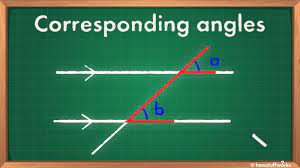Importance of corresponding angles in geometry – Math
What is the corresponding angles
how corresponding angles are formed when two lines intersect. A right angle is what you get when the lines intersect at a 90 degree angle, but any other type of angle can also be formed depending on how the two intersecting lines cross.
In geometry, corresponding angles are formed where a line known as an intersecting line or transversal crosses two other lines. When you create two parallel lines and then cross them with a third line it creates both parallel and congruent corresponding angles. A right angle is what you get when the lines intersect at a 90 degree angle, but any other type of angle can also be formed depending on how the two intersecting lines cross.
When you create an obtuse triangle by drawing a transversal across two parallel lines, corresponding angles are not congruent since one is more than 90 degrees and the other is less than 90 degrees. When you create an acute triangle by drawing a transversal across two parallel lines, both corresponding angles are less than 90 degrees. When you draw a perpendicular line at the point where two parallels intersect then all of the drawn angles will be right angles and both pairs of corresponding angles will be congruent.
Do you want to know – Are corresponding angles equal to 180?
It is important to note that in geometry, two corresponding angles are not always equal. For example, in an obtuse triangle, the horizontal corresponding angle (opposite the transversal line) will be greater than 90 degrees while the other will be less than 90 degrees -but both are equivalently located on the same side of the transversal. In an acute triangle, corresponding angles are also unequal; one is less than 90 degrees and the other is greater than 90 degrees because congruent angles in geometry always measure exactly 180 degrees.
When two parallel lines intersect with a perpendicular line, both pairs of corresponding angles will be right angles and in geometric terms they will also be said to “measure exactly 180 degrees.”
Importance of corresponding angles
Corresponding angles are important for understanding geometry and how it relates to situations in the real world. Let’s examine an example of how corresponding angles form the shape of an acute triangle.
An acute triangle is any type of triangle where two or three of its angles are less than 90 degrees (See diagram). One way to remember this is that acute means less than 90 degrees, so all three angles could never be larger than 90 degrees- something would have to change. As mentioned before, an acute triangle will always have one angle that will be greater than 90 degrees (the other two will be less than 90 degree). There are different types of acute triangles with their corresponding different angles, but this article will focus on the type where the angle somewhere between the base and top of the triangle is greater than 90 degrees. This creates a right angle at the base of the triangle where it intersects with the ground, giving us what we call an acute triangle.




